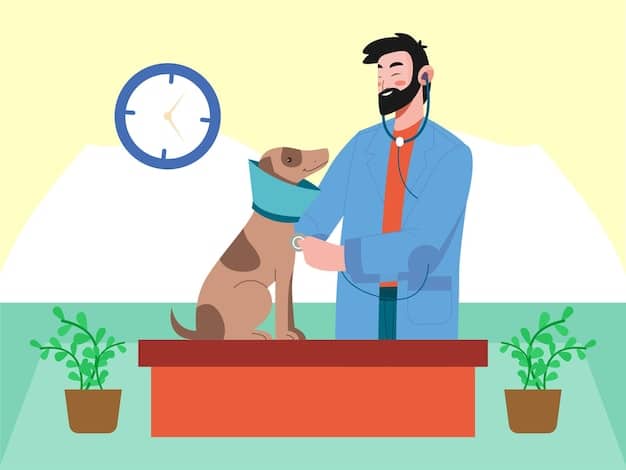Understanding Animal Aggression: Triggers and Prevention

Understanding Animal Aggression: Identifying Triggers and Prevention Strategies involves recognizing the underlying causes of aggressive behavior in animals and implementing effective management techniques to mitigate risks, ensuring a safer environment for both animals and humans.
Understanding Animal Aggression: Identifying Triggers and Prevention Strategies is crucial for pet owners, animal professionals, and anyone interacting with animals. Aggression can stem from various factors, and addressing these triggers is essential for creating a harmonious environment.
Understanding the Basics of Animal Aggression
Animal aggression is a complex behavior influenced by a combination of genetic, environmental, and learned factors. It represents a deviation from an animal’s typical demeanor, often stemming from fear, frustration, or perceived threats. Identifying the root causes and triggers for aggression is the first step in effectively managing and preventing aggressive incidents.
Aggression isn’t solely about physical confrontation. It encompasses a range of behaviors, from subtle displays like growling or hissing to more overt actions such as biting or attacking. Recognizing these early warning signs allows for timely intervention, helping to de-escalate situations before they escalate into physical altercations.
Types of Aggression
Different types of aggression manifest based on the underlying motivations. Each type requires a tailored approach to prevention and management.
- Fear-based aggression: Triggered by perceived threats or anxiety-inducing situations.
- Territorial aggression: Displayed to protect resources, space, or social groups.
- Possessive aggression: Focused on guarding specific items, such as food, toys, or even people.
- Pain-induced aggression: Results from physical discomfort or injury.
Differentiating these types of aggression is critical. For instance, an animal displaying fear-based aggression might benefit from gradual desensitization techniques, while one exhibiting territorial aggression may require modifications to its living environment.
Common Triggers of Aggressive Behavior
Various stimuli can elicit aggression in animals, each impacting their behavior differently. Identifying these triggers is vital for implementing appropriate preventive measures. Triggers can range from environmental factors like loud noises to specific social interactions.
Understanding these triggers requires a keen observation of the animal’s behavior and a consideration of its past experiences. Animals that have experienced trauma or negative associations with certain stimuli are more likely to display aggressive reactions.

Environmental Triggers
The surroundings can significantly influence an animal’s propensity for aggression. Overcrowding, loud noises, or unfamiliar settings can induce stress and lead to aggressive outbursts.
- Loud noises: Thunderstorms, fireworks, or construction sounds can trigger anxiety and aggression.
- Unfamiliar environments: New homes, boarding facilities, or veterinary clinics can induce stress.
- Overcrowding: Limited space can lead to competition for resources and increase aggression.
Mitigating these environmental triggers involves creating a safe and predictable environment. Providing quiet spaces, gradual introductions to new settings, and ample personal space can help reduce the likelihood of aggression.
Prevention Strategies for Animal Aggression
Preventing aggression begins with establishing a foundation of trust and positive reinforcement. Early socialization and training play pivotal roles in shaping an animal’s behavior and reducing the likelihood of aggression.
Effective prevention strategies are proactive and focus on addressing the underlying causes of aggression. These methods are designed to teach animals alternative responses to triggers, fostering a more balanced and predictable behavior.
Early Socialization and Training
Exposing young animals to a variety of experiences, people, and other animals can significantly reduce the risk of future aggression. Positive reinforcement training can teach them to respond to commands and manage their impulses.
- Exposure to various stimuli: Introduce puppies and kittens to different sounds, sights, and textures.
- Positive reinforcement: Reward good behavior with treats, praise, or toys.
- Basic obedience training: Teach commands such as “sit,” “stay,” and “leave it.”
By investing in early socialization and training, owners can equip their pets with the skills needed to navigate various situations without resorting to aggression. This approach promotes a well-adjusted temperament and strengthens the bond between animal and owner.
Managing Existing Aggressive Behaviors
When faced with established aggressive behaviors, a multi-faceted approach is often necessary. This may involve consulting with veterinary behaviorists, implementing behavior modification techniques, and, in some cases, using medication to manage underlying anxiety or hormonal imbalances.
Successful management requires patience, consistency, and a commitment to understanding the root causes of the aggression. It’s about creating a strategy that addresses not only the symptoms but also the underlying emotional and physiological factors.

Seeking Professional Help
When dealing with severe or persistent aggression, consulting with a qualified veterinary behaviorist or certified professional dog trainer is essential. These experts can provide tailored guidance and support, helping to ensure a successful outcome.
Professional assistance is particularly valuable when the aggression poses a safety risk to the animal or others. These specialists have the knowledge and experience to assess the behavior, identify underlying issues, and devise effective management strategies.
Creating a Safe Environment
A safe environment is indispensable for preventing and managing aggressive behaviors. This involves careful consideration of the animal’s physical surroundings, social interactions, and daily routines. By addressing potential stressors, owners can minimize the likelihood of aggressive incidents.
This proactive approach requires continuous monitoring and adjustment based on the animal’s individual needs and responses. It is an ongoing process of creating a secure and stable atmosphere.
Understanding animal aggression involves identifying specific triggers and implementing effective strategies. Recognizing the nuanced nature of aggression in animals, and the importance of creating a safe and stimulating environment, owners can mitigate the risks associated with aggressive behavior, ensuring a higher quality of life for the animal and those around it.
| Key Point | Brief Description |
|---|---|
| ⚠️ Identifying Triggers | Recognizing stimuli that provoke aggressive responses. |
| 🛡️ Prevention Strategies | Implementing measures to reduce the likelihood of aggression. |
| 👨⚕️ Professional Help | Seeking expert advice for severe or persistent cases. |
| 🏡 Safe Environment | Creating a secure and stress-free atmosphere. |
Frequently Asked Questions (FAQ)
▼
Initial signs include growling, hissing, baring teeth, stiff body posture, and prolonged staring. Recognizing these early signals can help prevent escalation.
▼
Early socialization exposes young animals to various stimuli, people, and other animals, helping them develop appropriate social skills and reduce fear-based aggression.
▼
Seek professional help if the aggression is severe, persistent, or poses a safety risk to the animal or others. Veterinary behaviorists can provide tailored solutions.
▼
Environment significantly impacts aggression. Overcrowding, loud noises, and unfamiliar settings can induce stress, leading to aggressive behavior. A safe environment is crucial.
▼
Yes, in some cases, medication can help manage underlying anxiety or hormonal imbalances contributing to aggression. This should be determined by a veterinary behaviorist.
Conclusion
Understanding animal aggression is a multifaceted endeavor requiring careful observation, proactive management, and, in some cases, professional intervention. By identifying triggers, implementing preventative strategies, and creating a safe environment, owners can mitigate the risks associated with aggressive behavior, ensuring a higher quality of life for their animals and those around them.





